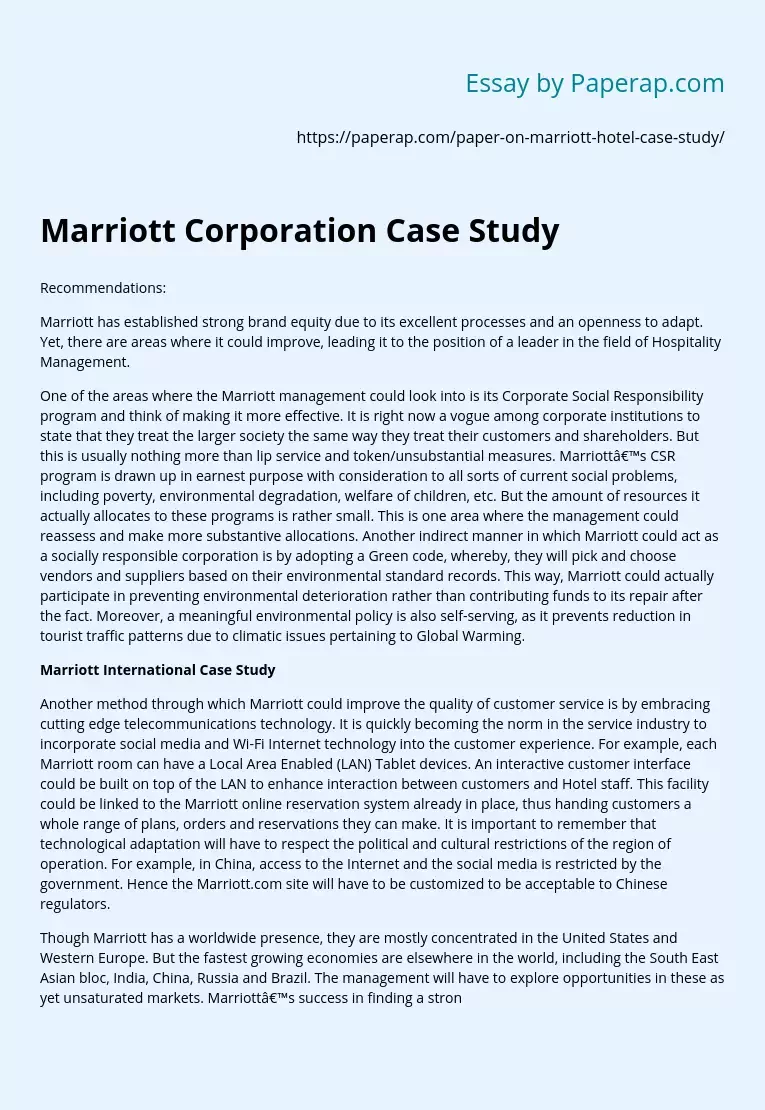Marriott Corporation Case Study
Recommendations:
Marriott has established strong brand equity due to its excellent processes and an openness to adapt. Yet, there are areas where it could improve, leading it to the position of a leader in the field of Hospitality Management.
One of the areas where the Marriott management could look into is its Corporate Social Responsibility program and think of making it more effective. It is right now a vogue among corporate institutions to state that they treat the larger society the same way they treat their customers and shareholders.
But this is usually nothing more than lip service and token/unsubstantial measures. Marriott’s CSR program is drawn up in earnest purpose with consideration to all sorts of current social problems, including poverty, environmental degradation, welfare of children, etc. But the amount of resources it actually allocates to these programs is rather small. This is one area where the management could reassess and make more substantive allocations. Another indirect manner in which Marriott could act as a socially responsible corporation is by adopting a Green code, whereby, they will pick and choose vendors and suppliers based on their environmental standard records.
This way, Marriott could actually participate in preventing environmental deterioration rather than contributing funds to its repair after the fact. Moreover, a meaningful environmental policy is also self-serving, as it prevents reduction in tourist traffic patterns due to climatic issues pertaining to Global Warming.
Marriott International Case Study
Another method through which Marriott could improve the quality of customer service is by embracing cutting edge telecommunications technology.
It is quickly becoming the norm in the service industry to incorporate social media and Wi-Fi Internet technology into the customer experience. For example, each Marriott room can have a Local Area Enabled (LAN) Tablet devices. An interactive customer interface could be built on top of the LAN to enhance interaction between customers and Hotel staff. This facility could be linked to the Marriott online reservation system already in place, thus handing customers a whole range of plans, orders and reservations they can make. It is important to remember that technological adaptation will have to respect the political and cultural restrictions of the region of operation. For example, in China, access to the Internet and the social media is restricted by the government. Hence the Marriott.com site will have to be customized to be acceptable to Chinese regulators.
Though Marriott has a worldwide presence, they are mostly concentrated in the United States and Western Europe. But the fastest growing economies are elsewhere in the world, including the South East Asian bloc, India, China, Russia and Brazil. The management will have to explore opportunities in these as yet unsaturated markets. Marriott’s success in finding a strong foothold in these emerging markets will be key to the company’s growth in the near future. As indicated by the PESTEL analysis, local legislations have a say on the prospects for the Hospitality industry in general and Marriott in particular. As Marriott attempts to gain market share and loyalty base in emerging economic powers, the management will have to devise culturally and politically sensitive plans for each of these countries. This is especially true in the era of terrorism, where Marriott’s strong perception as an American company can work against it. A common broad-based plan that doesn’t appreciate diverse socio-political realities across regions of operation is bound to fail. The Marriott management will have to think twice before consolidating their market position in countries where authoritarian regimes are in place. Such an association could negatively impact its brand. Likewise, the company can reassess its tendency to allow franchises to run its units in remote geographies. The command chain from the top-central management to its entry-level staff is also broken in the franchise arrangement. This can have a detrimental effect on its brand value in the long run.
Marriott will also prosper by looking at the supply-chain processes of competitors like Hilton and Radisson and learning from them. It may be counter-intuitive to adopt such an approach, but an open mind and respect for successful practices employed by competitors can only serve the company in the long run. At the same time, Marriott should also invest in generating creative ideas for offering its services. A positive and unique customer experience is invaluable in the hospitality industry and is key to establishing customer loyalty. Hence the hotel group should balance between following time-tested management practices while also experimenting with innovative ideas.
Finally, Marriott can think of venturing into industries allied to the Hospitality industry. Travel agencies and tour operators are a good choice, as there are financial incentives to be had in broadening the portfolio thus. Introducing customer loyalty programs into this mix is also a sound idea – customers are given credits (which could later be redeemed) is a sound business strategy. Also, now that the global economic slowdown is the biggest detriment to the fortunes of the Hospitality industry, Marriott group can think of focusing more on economy accommodation and travel till economic conditions pick up steam.
Marriott Corporation Case Study. (2019, Dec 05). Retrieved from https://paperap.com/paper-on-marriott-hotel-case-study/

